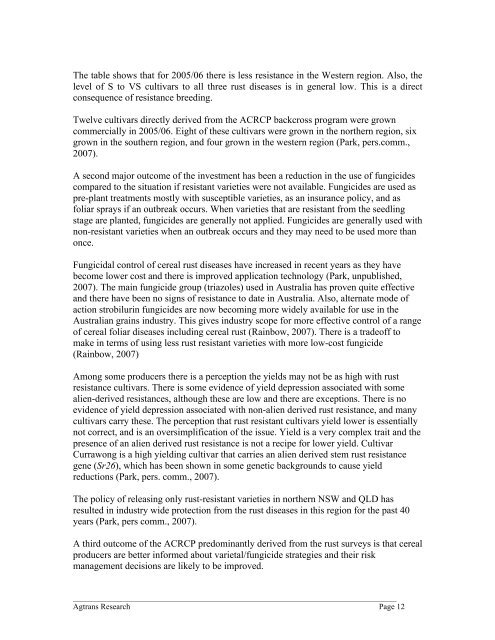An Economic Analysis of GRDC Investment in the - Grains Research ...
An Economic Analysis of GRDC Investment in the - Grains Research ...
An Economic Analysis of GRDC Investment in the - Grains Research ...
Create successful ePaper yourself
Turn your PDF publications into a flip-book with our unique Google optimized e-Paper software.
The table shows that for 2005/06 <strong>the</strong>re is less resistance <strong>in</strong> <strong>the</strong> Western region. Also, <strong>the</strong><br />
level <strong>of</strong> S to VS cultivars to all three rust diseases is <strong>in</strong> general low. This is a direct<br />
consequence <strong>of</strong> resistance breed<strong>in</strong>g.<br />
Twelve cultivars directly derived from <strong>the</strong> ACRCP backcross program were grown<br />
commercially <strong>in</strong> 2005/06. Eight <strong>of</strong> <strong>the</strong>se cultivars were grown <strong>in</strong> <strong>the</strong> nor<strong>the</strong>rn region, six<br />
grown <strong>in</strong> <strong>the</strong> sou<strong>the</strong>rn region, and four grown <strong>in</strong> <strong>the</strong> western region (Park, pers.comm.,<br />
2007).<br />
A second major outcome <strong>of</strong> <strong>the</strong> <strong>in</strong>vestment has been a reduction <strong>in</strong> <strong>the</strong> use <strong>of</strong> fungicides<br />
compared to <strong>the</strong> situation if resistant varieties were not available. Fungicides are used as<br />
pre-plant treatments mostly with susceptible varieties, as an <strong>in</strong>surance policy, and as<br />
foliar sprays if an outbreak occurs. When varieties that are resistant from <strong>the</strong> seedl<strong>in</strong>g<br />
stage are planted, fungicides are generally not applied. Fungicides are generally used with<br />
non-resistant varieties when an outbreak occurs and <strong>the</strong>y may need to be used more than<br />
once.<br />
Fungicidal control <strong>of</strong> cereal rust diseases have <strong>in</strong>creased <strong>in</strong> recent years as <strong>the</strong>y have<br />
become lower cost and <strong>the</strong>re is improved application technology (Park, unpublished,<br />
2007). The ma<strong>in</strong> fungicide group (triazoles) used <strong>in</strong> Australia has proven quite effective<br />
and <strong>the</strong>re have been no signs <strong>of</strong> resistance to date <strong>in</strong> Australia. Also, alternate mode <strong>of</strong><br />
action strobilur<strong>in</strong> fungicides are now becom<strong>in</strong>g more widely available for use <strong>in</strong> <strong>the</strong><br />
Australian gra<strong>in</strong>s <strong>in</strong>dustry. This gives <strong>in</strong>dustry scope for more effective control <strong>of</strong> a range<br />
<strong>of</strong> cereal foliar diseases <strong>in</strong>clud<strong>in</strong>g cereal rust (Ra<strong>in</strong>bow, 2007). There is a trade<strong>of</strong>f to<br />
make <strong>in</strong> terms <strong>of</strong> us<strong>in</strong>g less rust resistant varieties with more low-cost fungicide<br />
(Ra<strong>in</strong>bow, 2007)<br />
Among some producers <strong>the</strong>re is a perception <strong>the</strong> yields may not be as high with rust<br />
resistance cultivars. There is some evidence <strong>of</strong> yield depression associated with some<br />
alien-derived resistances, although <strong>the</strong>se are low and <strong>the</strong>re are exceptions. There is no<br />
evidence <strong>of</strong> yield depression associated with non-alien derived rust resistance, and many<br />
cultivars carry <strong>the</strong>se. The perception that rust resistant cultivars yield lower is essentially<br />
not correct, and is an oversimplification <strong>of</strong> <strong>the</strong> issue. Yield is a very complex trait and <strong>the</strong><br />
presence <strong>of</strong> an alien derived rust resistance is not a recipe for lower yield. Cultivar<br />
Currawong is a high yield<strong>in</strong>g cultivar that carries an alien derived stem rust resistance<br />
gene (Sr26), which has been shown <strong>in</strong> some genetic backgrounds to cause yield<br />
reductions (Park, pers. comm., 2007).<br />
The policy <strong>of</strong> releas<strong>in</strong>g only rust-resistant varieties <strong>in</strong> nor<strong>the</strong>rn NSW and QLD has<br />
resulted <strong>in</strong> <strong>in</strong>dustry wide protection from <strong>the</strong> rust diseases <strong>in</strong> this region for <strong>the</strong> past 40<br />
years (Park, pers comm., 2007).<br />
A third outcome <strong>of</strong> <strong>the</strong> ACRCP predom<strong>in</strong>antly derived from <strong>the</strong> rust surveys is that cereal<br />
producers are better <strong>in</strong>formed about varietal/fungicide strategies and <strong>the</strong>ir risk<br />
management decisions are likely to be improved.<br />
________________________________________________________________________________<br />
Agtrans <strong>Research</strong> Page 12

















